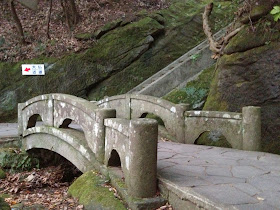Along a bay coastal train line in Chiba Prefecture is a nice mountain with good views and great hiking.
There are two approaches to Nokogiriyama. It is possible to hike to the top from Hota Station, or you can take the route we took, starting at the top with the cable car from Hamakanaya Station. The town of Kanaya can be seen in the photo above.The view on the ride up is wonderful, and you can see the interesting mountain formations and Tokyo Bay. If it's clear enough, you should be able to see across the bay to Miura Peninsula. Nokogiriyama translates to Sawtooth Mountain, due to its shape.
The town of Hota is off to the left (south).
A building at the top leads out to an observation area, but I think the views from the cable car are just as nice. From here you can start your hike.
Near the top is a small shrine. You can get a fortune here and pray.
I wonder what kind of god resides here.
The main trail forms a sort of figure 8 with some additional connecting trails and branches. Be sure to consult the map to see everything you want to see.
Near the to of the mountain, for instance, there is a fork in the trail. Head left, here.
It's a nice narrow canyon trail.
It's not exactly natural, but it is beautiful. And at the end of the trail, a beautiful sight awaits.
This is one of two large carved stone features in the park. It's relatively new.
This is essentially the end of the trail - look up and wave at anybody standing on the rock, and head back.
Oooh. Artsy shot. When you return to the fork in the trail, head up the stairs to the top of the cliff, where you can look out from the rock outcrop in the prior photo. The view is nice but not spectacular. An expressway is visible winding through the mountains.
I had to practice my nature photography.
Macro photography is my friend.
This is what the above photo would have looked like if it was snowing. (I didn't make this photo on purpose - Picasa automatically added this and I felt it was worth mentioning that Picasa did it without my asking.)
From the top of the mountain, head down the right side of the 8 and then across the middle. Here the trail is mostly in the shade and leads down the mountain.
Along this route sits over 500 little arhat statues.
They have different faces and poses.
They are somewhat grouped according to style.
The trail is carved into the side of the mountain, as are the little caves housing the little statues. As you can see here sometimes there are caves.
Some of the statues are damaged, missing heads or limbs.
Mind your step as you walk in some areas, as the tree roots sometimes sit right on the ground.
You are being watched.
This portion of the hike is relaxing and really enjoyable, as you see something new every few minutes.
A small spur up some stairs leads to a cove of statues.
543 statues is a lot.
I would like to have a statue of my own. I don't want to steal one of these; instead I would like a replica.
Across the small bridge, you reach the left edge of the figure 8. Head to the left and down the mountain as you swing around some more.
Watch your head! You're almost to the main attraction.
At the bottom of the trail, about halfway down the mountain, is the largest stone statue of Buddha. It stands about 30 meters tall, and was created in the 1700s along with all the little statues. The mountain was also used as a quarry during the Edo period, which resulted in the formation of some of the canyons and caves found on the trails.
We originally planned to take the cable car back down the mountain. As you can see here, it was getting late by the time we made it to the statue, and had to almost run back up the mountain - there are a lot of stairs if you go straight up the sides without taking the middle part of the 8. As I mentioned earlier, it's possible to access the mountain on foot from the south, and I recommend that as the way out if you start at the top.
Coming from the north, it's about 15 minute walk to the cable car (900 yen round trip). From the south, the trail is about 15 minutes from the train station - but I think you should expect a full extra hour getting up to the figure-eight trail. Entrance to the temple (and thus all the trails) is a steep (pun intended) 1000 yen, but I'm sure it isn't cheap keeping a temple like this in order. Access to both Hamakanaya (for the cable car) and Hota (to hike only) take more than two hours from the Tokyo area, including an 80-minute local train ride from Chiba Station. Plan on staying at least an hour, though if you want to take your time enjoying the statues and strolling down the trail you should plan for a longer stay.
With the long train trip, it might be a good idea to combine this stop with others along the peninsula. There aren't many, but you could look at Kujukuri-hama beach, Kamogawa Sea World, Mother Farm, and Tokyo German Village.
































No comments:
Post a Comment